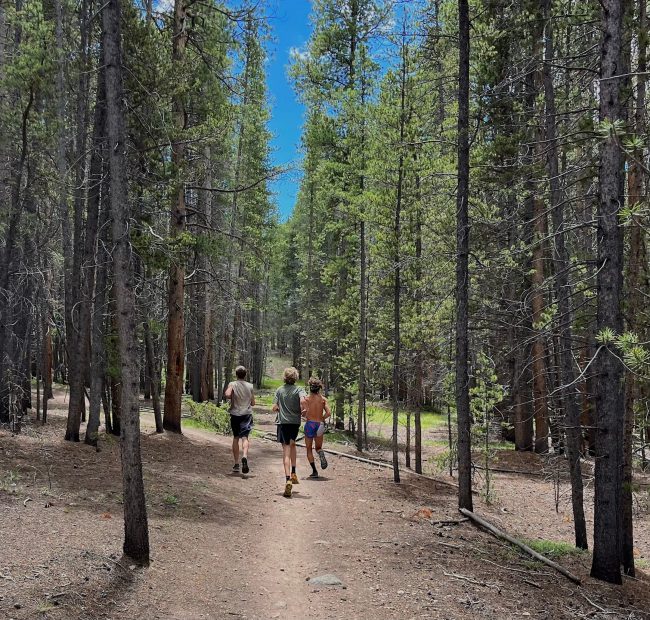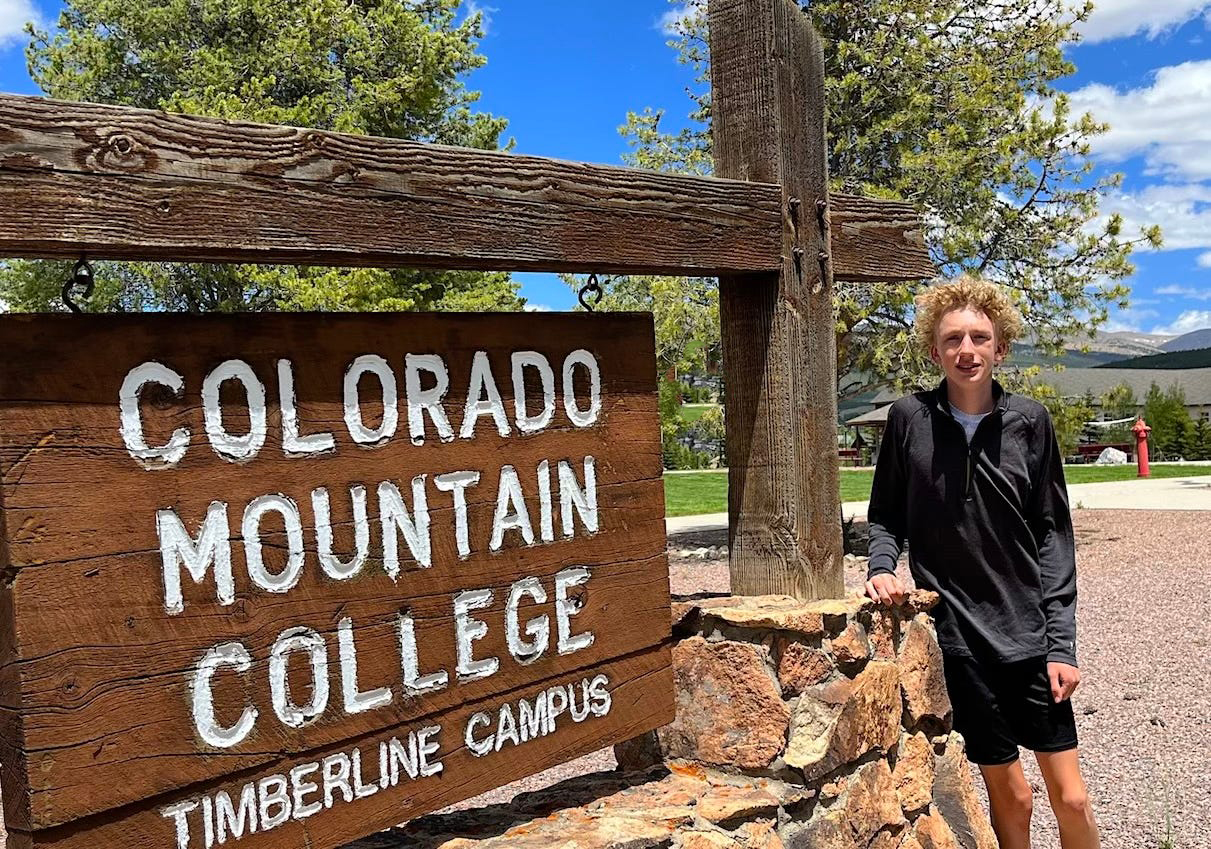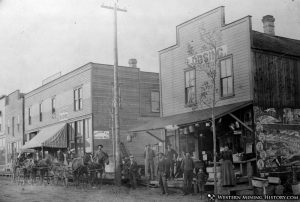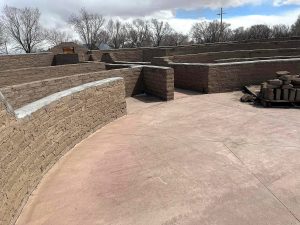If you have ever spent any time over the past four decades on the dirt roads and mountain trails or attended any of the burro “Triple Crown” races in the mountain towns along the Upper Arkansas River Basin, you probably have seen Hal Walter loping along at a steady running pace. If you did see him in the early years, Hal might have been alone, motoring along with a running stride that, at a distance, deceptively seemed like nothing more than a very slow jog until you got closer and saw how far he had already run. Sometimes, he was driving a burro on a long lead rope in front of him, rhythmically swinging the end of the rope in time with the footsteps of his four-legged running companion, a noticeable dust cloud rising in the wake of their plodding trail.
Over time, Hal was not alone in these runs, either the two-footed or four-legged varieties, down dusty county roads. I remember the first time noticing the change in Hal’s training runs when I was driving to Westcliffe and seeing Hal, his wife Mary, and their young son Harrison running together, three burros for three runners in hot early July heat as they trained for the looming Pack Burro race series in Leadville, Fairplay, and Buena Vista. The calm patience of their rhythmic cadence made the odd sight of a family of burro runners seem almost – normal.
Despite Hal’s longstanding dedication and expertise in the Colorado sport known as “Pack Burro Racing,” I have known Hal as much more than “just” a remarkable endurance athlete. Those who did not recognize his silhouette on the trails more often recognized his byline in newspapers and magazines. Since graduating from journalism school at the University of Colorado in 1982, Hal has worked at newspapers up and down the Arkansas River in Colorado. From writing and editing at the Pueblo Chieftain to his time at the Leadville Herald-Democrat, tensely writing about the Environmental Protection Agency working to clean up mining pollution in the Arkansas Headwaters and having his tires slashed by angry locals at the very notion of him reporting on such “government interference” into clean water efforts; Hal has just about written it all.
But despite his ample writing chops, nothing really prepared him for the adventure he is now embarked on. He is co-writing, with his son Harrison, the experience of Harrison going to Colorado Mountain College in Leadville after graduating from Custer County High School in 2022. While Harrison graduated from Colorado Mountain College in 2024, the two are now 57 parts into a serialization of what happened when a young man with autism attended college. On top of all this, Harrison was a collegiate cross-country and track athlete who was simultaneously pursuing an associate of general studies degree and welding certificates.
For both father and son, the series The Blur Goes to College, which is published on the newsletter platform Substack, has once again plunged them both into the unknown.

“It’s part comedy and part tragedy, part train wreck, part triumph. Moreover, this is a story of empathy and compassion, and exploring the rights of people with so-called ‘intellectual disabilities.’” This fitting introduction is the best way to sum up the still ongoing project. For writers like me, it is hard to review the series without risking taking away the stunning electricity that comes from each installment. “Trying to catch lightning in the bottle” is an apt description as Hal and Harrison manage to engage in this dual autobiography about attending college with what some label a “disability” without ever falling into the usual stereotypes. Clearly, the tradition of mountain endurance running, feats of athleticism that require an unusually stoic attitude, played a considerable role in pressing ahead despite the almost overwhelming challenges.
Some installments are triumphant, such as when Harrison, against all odds and expectations, scores points as a freshman for his team in well-known and prestigious cross-country tournaments. His tall and lanky frame, which had long trained on the dirt roads and trails of Custer County, propelled him to achieve national success in the sport. Other segments will jog the memory and feelings of many who remember the frustration and isolation of college, but through the eyes of father and son with the emotional rawness dialed up to 20 on a radio that only goes up to 10. Not to mention the comedy of Hal navigating college dorm life at the age of 62.
Of the many themes that intertwine, the autobiographical narrative is one of constant questions on how even to define autism and if that is even what Harrison truly experiences. The moniker “neurodivergent” is more suited as autism is one of those terms often used but impossible to define with any certainty, even by the experts. The segments written by Harrison, and sometimes narrated by him in audio installments, shed a rare glimpse into his world and an inescapable realization that many of us can see how our emotions are not so different, just that Harrison experiences them at an intensity we find unfamiliar.

When talking with Hal and Harrison about the series, they both rightfully did not define the work solely as a publication about going to college with a learning disability. For Hal, he captures the worries of any parent when their kid leaves the house, except with a much sharper edge. Plus, there are the unavoidable reflections of change, reentering a town where he faced down managing and editing the local newspaper during a time of turmoil several decades earlier. Add to that mix the necessity of working with, and often battling against, the bureaucratic systems that demand all students check certain boxes of conformity; otherwise, they are punished. Many of the seemingly solid fundamentals of how to motivate students with carrots and sticks are exposed as a primitive chimera when the system is viewed through Harrison’s eyes.
Harrison, for his part, documents his success and struggles to learn the welding trade, running on a collegiate cross-country team that trains at 10,200 feet altitude, and trying to understand his fellow students and professors while constantly looking inward at his own emotional responses to the world he inhabits.
While the series centers on the father and son, the places they live and travel through are as much in focus as the experiences. In one telling scene, Harrison discovers a Western Union machine used for wiring money in a small Hispanic bodega that allows the many migrant workers living in Leadville (who serve the ski towns on the other side of the Continental Divide) to send money home to family members. Hal’s long experience as a writer shines in his ability to bring you along and run for a moment in his and his son’s shoes.

The decision to serialize the writing instead of just publishing a book is also a reflection that life experience is not something as easy as writing 50,000 words and slapping them between covers. Substack is a relatively new platform that allows writers like Hal and Harrison not only to publish their works but also to easily include pictures and audio recordings, all of which are emailed automatically to readers who have signed up. There is something thrilling about seeing a new notification pop up in my email that a new segment has been posted.
There is a discussion between Hal and Harrison that once the story wraps up in its own due time, a physical book might be forthcoming — the “wad of paper,” Hal calls it. As the old Venetian saying goes, “The sea gets deeper and deeper the further you go into it,” and the series has no indication of wrapping up anytime soon. The stories and pictures are free, but those who want to support the work can subscribe at different paid subscription rates.
Visit theblurgoestocollege.com to read and stay updated on this fascinating and original series and to subscribe to support his autobiographical project.

– Jordan Hedberg




